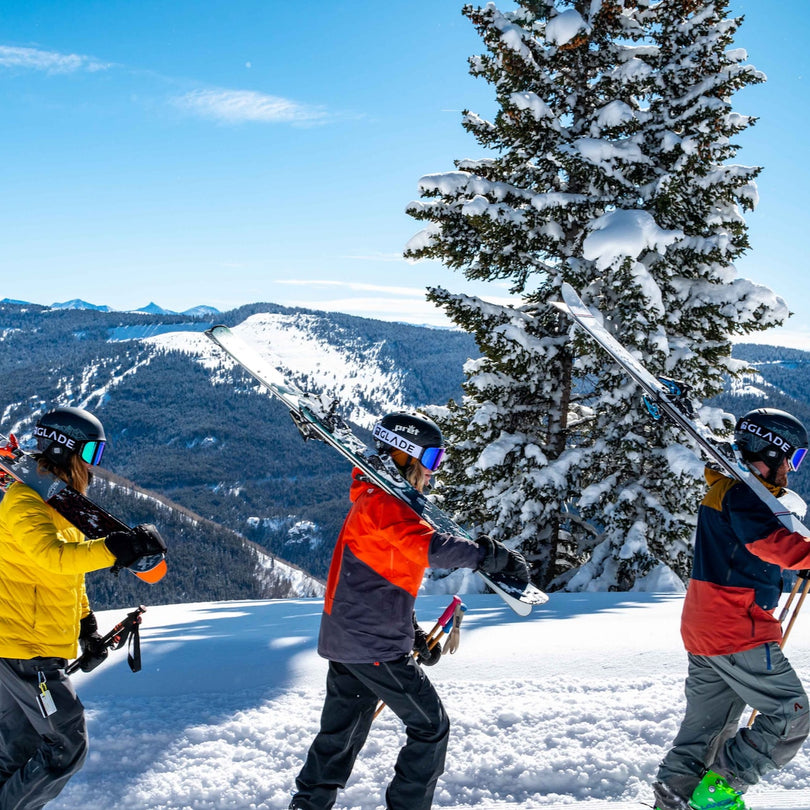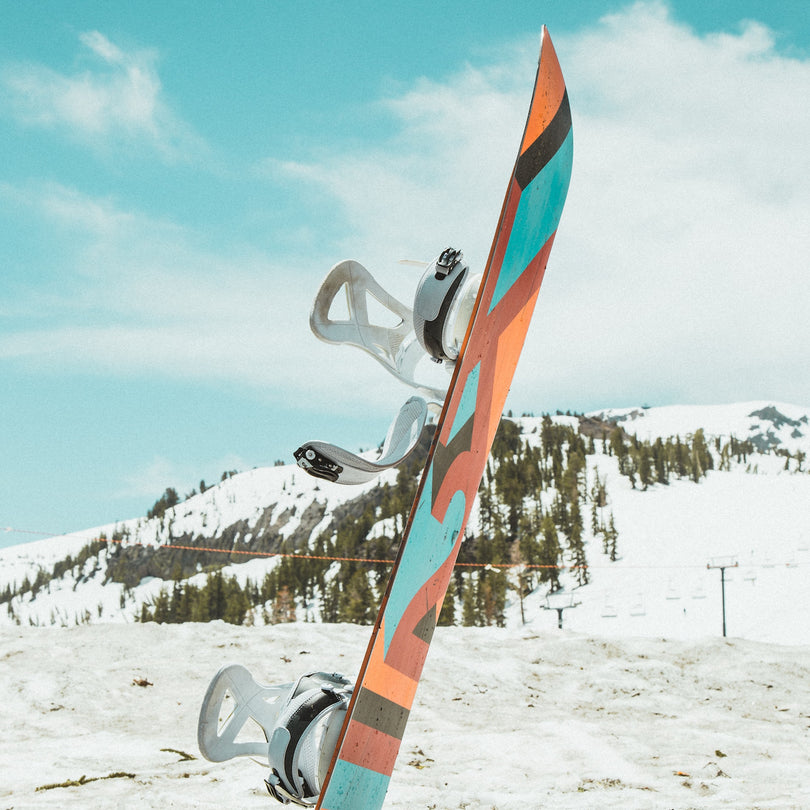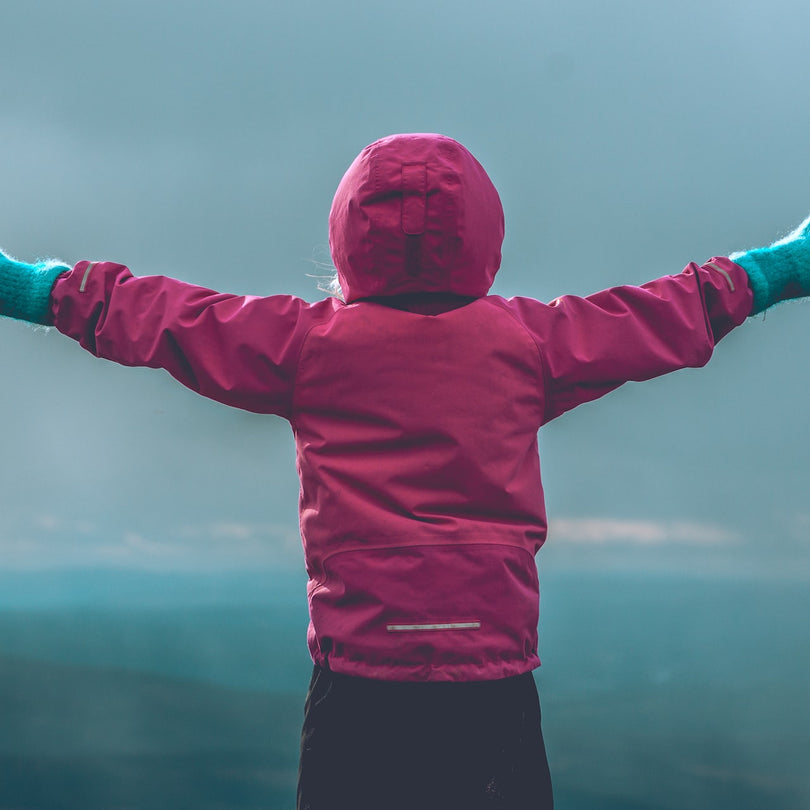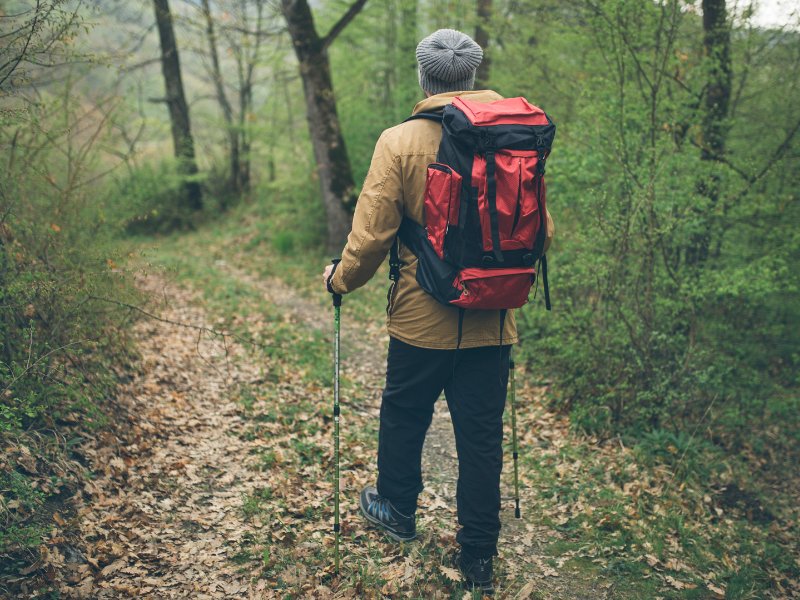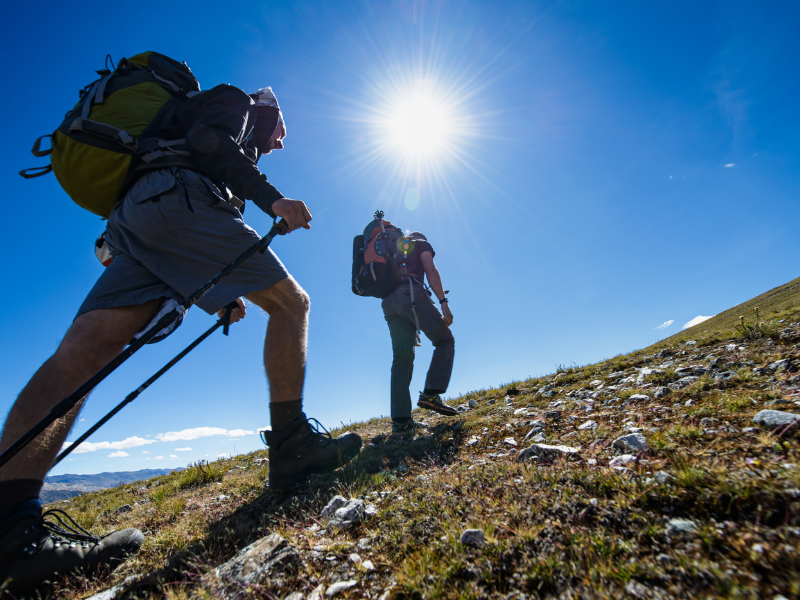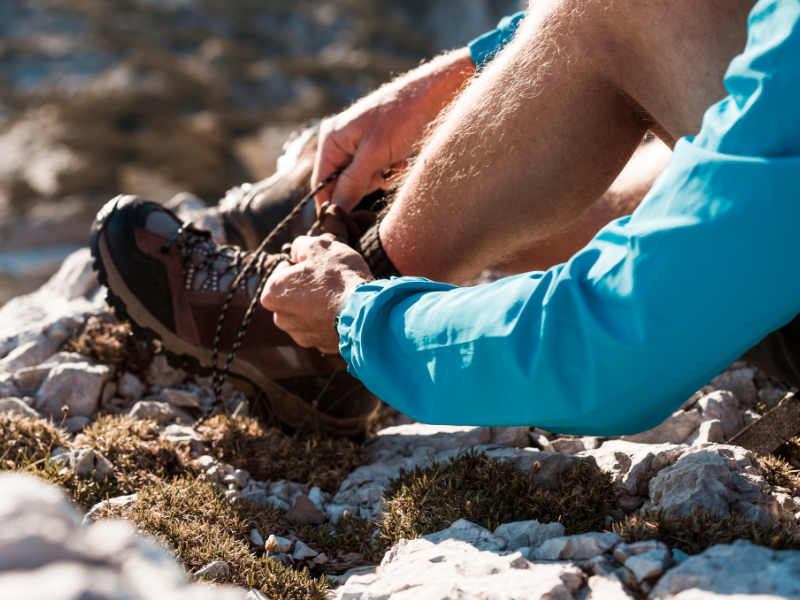What Are the Benefits of Trekking? Same Benefits as Hiking?
After many successful hikes, you’re ready to take it to the next level and go on a trek. Right now is about the time a hiker scratches their head and wonders how trekking could be the next level of hiking.
And to that, we'd first ask you to lower your voice, and then point out that there are eight benefits of trekking that make it next level to hiking.
So, what are the benefits of trekking then?
- Better physical fitness
- Great social experience
- Improved stamina
- Healthier heart
- Less stress
- Happier mood
- Spiritual connection
- Better life skills
In today’s guide, we’ll explain each of the trekking benefits above, so you can understand why this activity is so great for your health, mindset, and lifestyle.
Check out Kenver's extensive selection of hiking gear:
Kenver's Hiking Collection
What Do You Mean by Trekking? Same as Hiking?
If you read Kenver's recent article that explains the difference between hiking and trekking, you are now free to move about the cabin, aka skip this section.
If you haven't had a chance to read the post yet or want a tl;dr version instead, here's the brief refresher on trekking relative to hiking.
What is Trekking?
Trekking is a long-distance and multi-day journey, most commonly done on foot, and involves challenging terrain that can often change many times over the trek. Trekking routes often go through more difficult and remote areas than hiking, making for a more strenuous journey.
How is Trekking Different From Hiking?
In other words - think of it as going on a pilgrimage. Like an extended hike done on foot to reach a particular destination. That's part of what separates hiking and trekking. While hikers typically want to complete a trail, trekkers are more focused on getting from Point A to Point B.
How Long Does a Trek Take?
Most treks fall somewhere between several days and a couple of weeks. However, treks can last months and years. The time and length of a trek are up to the individual trekker, the planned distance, and the trekker’s pace.
Treks aren’t done exclusively on hiking trails; far from it. A trekker can venture onto rocky cliffs, sand, hills, and even paths that no one has yet to forge.
A trek can involve elements of hiking, scrambling, and trekking, which can impact difficulty and length. They might hike part of a trail before branching off and following their own path, or they might plan a long-distance trek that takes multiple days to complete.
Oh, and for the uninitiated, scrambling is hybrid of climbing and hiking. It can be as flat as a walkable hill to as steep as a cliff-side.
Trekking Shelter and Supplies
Trekkers have a wider range of shelter options too. They may be able to stop and sleep in cabins or hostels or build a tent each night.
As it relates to supplies, trekkers are also expected to carry the appropriate amount of food and water to sustain themselves for the duration of the trek, up to a certain extent.
But certainly far more supplies than what a hiker would carry.
The Top 8 Benefits of Trekking
Alright, with the trekking 101 out of the way, let's get to what you're really here for; the benefits packed into trekking, and perhaps that spark of motivation to begin your own adventure.
1. Better Physical Fitness
Most people hit the trails because they love nature, they love the smell of fresh air, and they love the challenge of pushing their limits. And first and foremost, a trek is pleasurable.
But just because something is enjoyable doesn’t mean it can't be good for you too - that's the best kind of combination.
And while any type of exercise is beneficial, trekking has some unique benefits, including:
Get Your Steps In
If you’re a more experienced trekker who’s maintaining a consistent walking or hiking pace of about two miles per hour, then you can easily achieve around 10 miles of distance walking per day.
Weight And Gravity
Trekking often involves hiking uphill, which helps to strengthen the legs and improve balance. As a weight-bearing exercise, you'll build stronger bones and muscles.
Add Pack Weight Into The Mix
Trekkers carry heavy loads full of food, water, additional clothing, and camping supplies. This adds a degree of resistance to everything they do, thus making the muscles work that much harder.
According to the backpacking food resource Greenbelly, if you weigh 175 pounds and your pack is 30 pounds, and if you maintain an average walking pace of two miles per hour and cross 10 miles, you’re burning 1,861 calories.
You'll Find New Muscles
As you trek, you’ll work your muscles in new and inventive ways, especially as you explore various types of terrain.
That's right, you'll probably discover muscles you didn't know you even had. If you’re carrying trekking poles, then you’re using upper body as well as lower body muscles while you walk.
You’re also stabilizing your core as you remain balanced, which is a valuable physical skill to possess.
So next time you hit the trails, and you feel guilt for missing leg day at the gym, just remember that you’re not just enjoying yourself—you’re also getting a great workout!
2. Great Social Experience
Do some trekkers set out on their own and keep to a lonesome trail for the duration of their journey? Absolutely.
But the more common approach is trekking with another person, or in a group. This could start with others, start solo and join a group, or start as a group and then splinter off throughout.
Whether solo or in a group, each comes with its advantages and disadvantages.
Advantages of Trekking Solo
The biggest advantage of a solo trek is not beholden to anyone else’s schedule or whims, and you can make decisions on the fly without having to consult with others.
This can be especially beneficial if you’re trying to do some soul-searching or introspection – being alone with your thoughts can be very clarifying.
Communing with nature is the biochar for the mind.
Plus, solo trekking doesn't have to mean solitude - it can be a great way to meet new people.
If you strike up conversations with other trekkers on the trail, you’ll likely find that they’re happy to chat and exchange tips (or even walk with you for a stretch).
So even though you may start alone, you may end up making some lifelong friends and if you prefer, you could end the journey in a group.
Advantages of Trekking in a Group
Trekking with others is a great way to strengthen bonds with friends, family, or newly acquainted trekkers. Shared experiences are the foundations of reminiscing after all, and believe it or not, but reminiscing is proven to reduce stress.
Except when your uncle reminisces at Thanksgiving, that usually heightens stress levels. But let's get back to trekking.
Shared experiences aren't the only benefit, you can also learn about all the unique motivations that have inspired your fellow trekkers, glean information on different trails and pathways, and perhaps even pick up a few camping and trekking tips.
And although difficult to quantify, the camaraderie of trekking makes what can be a very arduous experience feel far less so.
And for some people, being alone is just short of a curse. If you're that type of person, group treks will stave off loneliness, which can be important when you’re far removed from civilization.
3. Improved Stamina
While we'd never recommend embarking on a trek with the primary goal of building stamina, if your stamina levels are low or nonexistent, it’s proven that exercise is a critical factor in how much stamina one has.
Trekking is a great way to build your stamina. By nature, it requires you to be on your feet for extended periods and cover long distances. Time and distance are the twin pillars of stamina.
Treks aren't easy, and once you begin one, it can be difficult to evac. So you might begin your stamina-building journey in a gym or by going on walks.
As you improve, you'll see an increase in the amount of time that you can exercise without getting winded, then you’re ready for a short hike.
By the time you graduate from hiking to trekking (which requires several long, successful hikes), your stamina should be quite good. That said, it can always be better, right?
Trekking is a surefire way to reliably build long-lasting stamina.
You’ll have to take breaks when trekking, of course, as you’re not inhuman. However, you’ll find that your ability to traverse long distances will improve the more that you trek, especially compared to your hiking days.
4. Healthier Heart
What's the best thing you can do for your heart?
If you answered eat a bowl of Cheerios, then you need to keep reading. The answer of course is exercise - more specifically, cardiovascular exercise. It's the key to a healthier heart.
Running, rowing and cycling aren't the only ways to a good cardio workout. Hiking and trekking are fantastic activities for a healthier herat.
Although it's a bit dated, the science is still intact from a 1996 report in the Journal of the American Geriatrics Society states that “walking more than 4 hours/week was associated significantly with a reduced risk of cardiovascular disease hospitalization in both sexes combined compared with walking less than 1 hour/week.”
Now, the participants in this study were all 65 and older, so that may or may not be completely relevant to you.
But countless other studies have been published that support the same premise, and across various age groups as well.
If you're nodding your head that walking is good for the heart, then think about what trekking can do.
When trekking, you’re walking far more than four hours a week, but usually four hours per day and often more.
Trekking keeps the ticker going, and can help you burn calories in the process, which is a method to keep weight down. After all, obesity is one of the top risk factors for heart attack.
5. Less Stress
Stress has been touched on a couple of times already, but it's such a significant benefit of trekking, while also being a great malady to society, that it needs to be called out in more detail.
Stress can be good in some ways, but if it pulls a person to ongoing states of anxiety or depression, it's no longer a helpful response.
Damn amygdala.
If this doesn't sound like you, the odds are still high that someone you care about does have this experience.
According to The American Psychological Association (APA), it's estimated that about 48% of Americans have high stress, a number that surely goes up each year.
Now, not all stress leads to anxiety disorders, but the percentage of US citizens with high stress and the percentage of US citizens with anxiety disorders is quite similar.
While there are several actions people can take to work through those issues, Stanford University found that spending time in nature is a way to reduce depression risk, alleviate anxiety, and lower stress levels to boot.
Trekking is by no means a cure-all or even a treatment option for a serious medical condition.
Rather, the point is that trekking requires being outside extensively while doing an activity that works your mind and body, which the smart folks of Stanford believe at least has benefit.
6. Happier Mood
Building on the point above, less stress and anxiety in your life typically equates to feeling happier.
Even though trekking can be difficult, you might find yourself smiling more or having an increase in the rate of positive thoughts.
Sure, the exercise and mystic forests and landscapes have a role to play in this mood shift.
But don't forget about sunlight.
Spending time in the sun helps your body produce more vitamin D.
Vitamin D has many perks, such as lowering your heart disease risk, bettering immune health, and lessening your chance of developing multiple sclerosis.
More importantly, at least to our point, is that vitamin D can regulate our moods, even in people with depression.
While some foods you eat do contain vitamin D, getting a big dose of it from the sunlight will have a more profound effect.
Be it five hours or five weeks of sunlight on your journey, each minute of sunlight produces that positive vibe of vitamin D.
7. Spiritual Connection
Being alone with nature can be an incredibly soothing and rejuvenating experience. Free from the outside world's distractions, it’s easy to feel more connected to oneself and the environment around you.
There’s something incredibly soothing about being in nature, with only the sounds of creatures and fauna around you.
For some, this is an opportunity to reconnect with their physical bodies, spending time in peaceful reflection and introspection.
For others, it’s a chance to clear their minds and get in touch with their spiritual side.
Either way, spending time alone in nature is a great way to reduce stress and recharge one’s batteries.
Trekking is used interchangeably with pilgrimage, and this doesn't seem like a coincidence.
As a pilgrimage is "a journey or search of moral or spiritual significance," it's easy to see how the two concepts are linked.
When we're constantly on the go and plugged in, it can be difficult to find time for introspection and reflection.
Getting away from it all and spending time in nature on a trek can help us to remember what's important, while connecting with ourselves on a deeper level.
8. Better Life Skills
Saving the best for last, trekking helps you develop critical life skills that can come in handy in nature and everyday life. Seriously, check this out:
- Supply Management: You have to learn supply allotment as you go through your food, water, and other gear.
- Building Shelter: You’ll become privy to setting up a tent, as you’ll do that, again and again, most nights.
- Build a Fire: If you’re not already familiar, you’ll gain the opportunity to learn how to start a fire and how to safely put one out.
- Live off the Land: You may learn what it’s like to live off the land by fishing, foraging, and filtering water for potability.
- Intuition: Call it "Spidey-Senses" or whatever you like, but trekking in nature will fine-tune your intuition; you'll learn to assess danger and calm better with each step.
- Healing: If you get injured or another member of your trekking party does, you’ll become comfortable with mending them.
- Navigating: You’ll also have to learn how to navigate, find trails, read a compass, and follow a map.
Few activities provide so many valuable life skills. Some of these would be impressive at a party or on a first date, but others could actually save your life or someone else's one day.
Beat that tennis and golf!
Trekking, A Journey of Benefits
We've covered a lot of ground in this article (finally got a pun in.) And the big takeaway is that trekking is packed with benefits for a healthier you.
On the physical side, you'll gain stamina and cardiovascular health, burn some calories, and build muscles you can pronounce and others you've never heard of, in the process.
Mentally, you'll be able to destress, connect with nature and rekindle some much-needed time away from everything.
And if you venture out with friends or make a new one on the journey, you'll build some bonds that last a lifetime.
So, if you’ve been waiting for the impetus to go on a trek, may this article serve as your inspiration.
Check out Kenver's extensive selection of hiking gear:
Kenver's Hiking Collection

